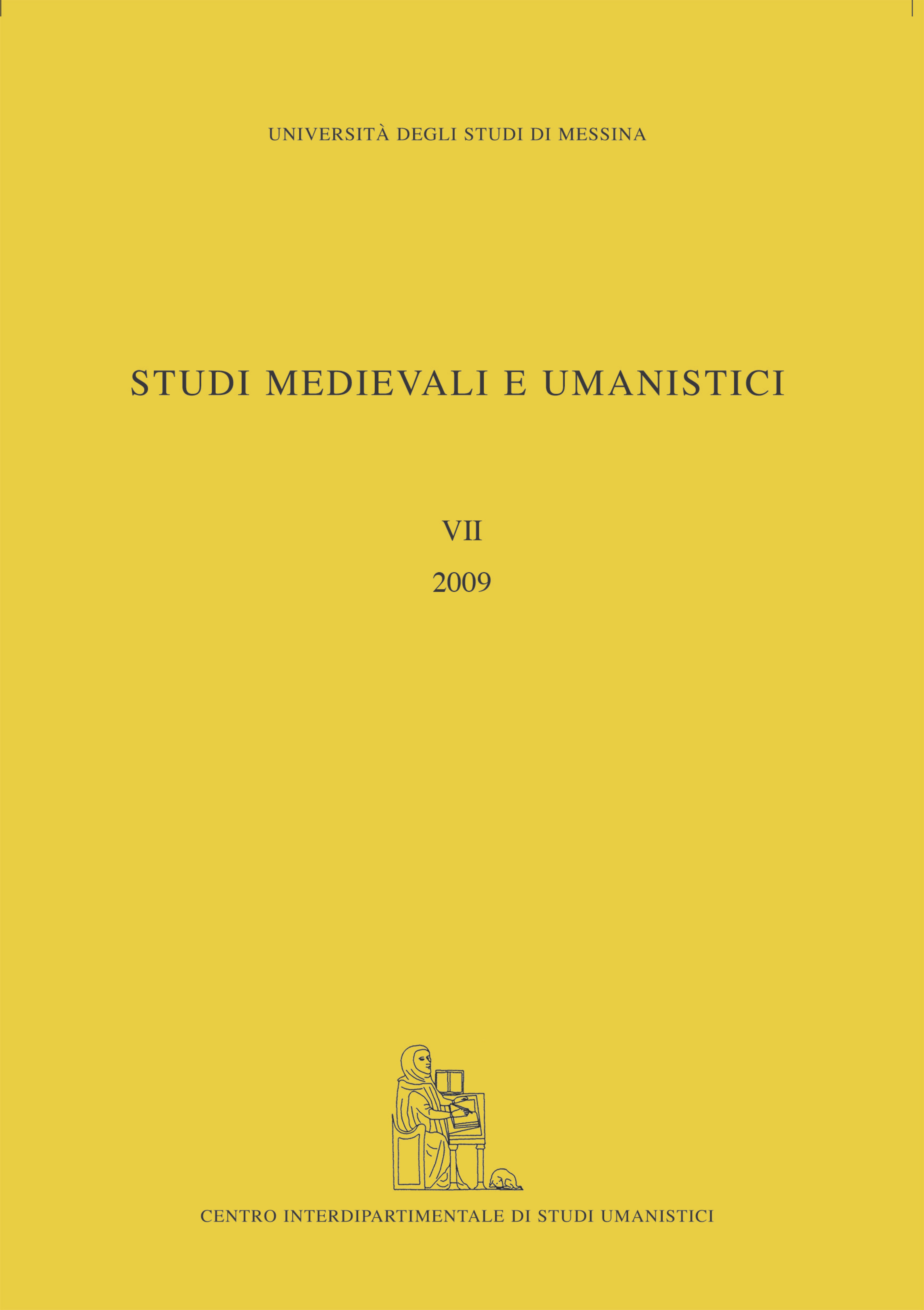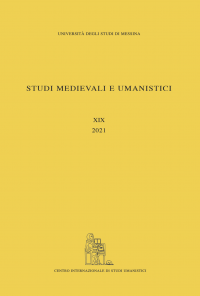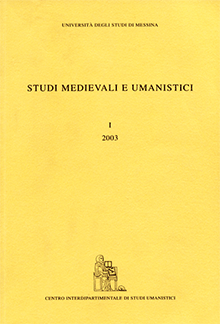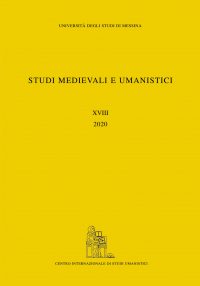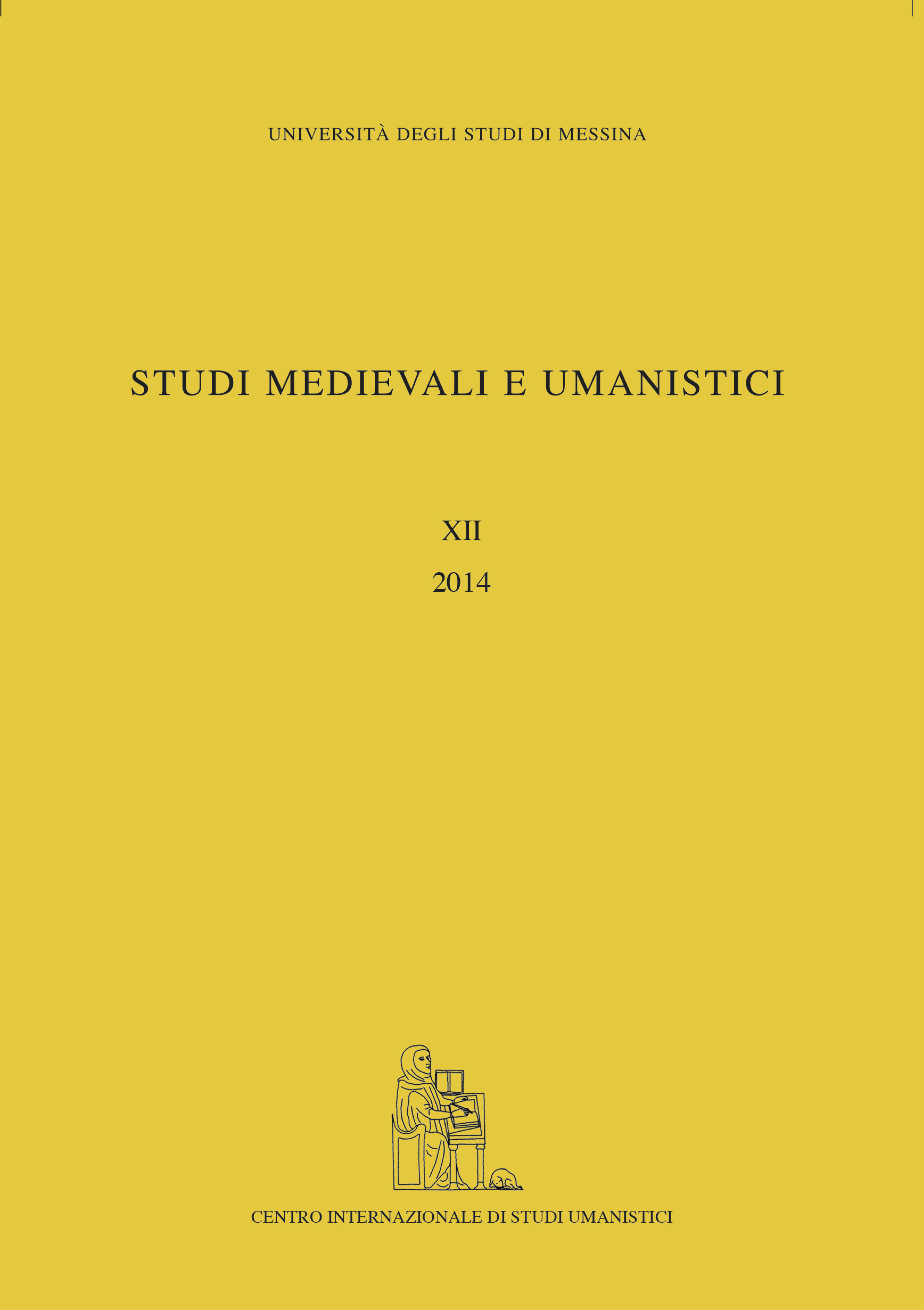Studi medievali e umanistici, VII
€ 120,00
Descrizione
VII (2009)
Messina, Centro Internazionale di Studi Umanistici, 2009, 480 pp., tavv. XXVII; 25 cm.
ISSN 2035-3774
INDICE GENERALE
Xavier van Binnebeke, Manoscritti di Coluccio Salutati nella Stadtbibliothek di Norimberga
Stefano Pagliaroli, Le Emendationes di Lorenzo Valla al Doctrinale di Alexander de Villedieu
Alessandro Daneloni, L’Exegesis in Homeri Iliadem di Giovanni Tzetzes tra Poliziano e Parrasio
Teresa Martínez Manzano, Traducciones humanísticas de la escuela de Andrónico Calisto en Bolonia
Paola de Capua, Letteratura di consumo a Roma nell’età di Leone X. Un omaggio poetico di Andrea da Montopoli
Appendice a cura di Cecilia Moretti
Nuala Distilo, Un’edizione dell’Elettra di Euripide con postille di Piero Vettori
Gemma Donati, Petrarca e Osberno di Gloucester
Monica Berté, Petrarca e le Philippicae: la lettura del Par. lat. 5802
Matteo Durante, L’inquieta tradizione della Strega del Lasca
Gian Paolo Marchi, Ancora sull’arcidiacono Pacifico di Verona
TESSERE
M. Bandini, Simeone di Bulgaria, l’‘incompiuto’ (Liudpr. Antap.
3, 29)
D. Gionta, Nuovi frammenti di un disperso codice delle Familiari
L. Tartaglia, Un epitafio inedito per Crisolora nel ms. Par. Coisl. gr. 313
M. Bandini, Due note bessarionee
F. Li Pira, Due testimonianze sui benefici ecclesiastici del cardinale Bessarione nei Libri Annatarum
M. Rinaldi, Una ritrovata tavola di corografia astrologica di Pietro Bono Avogaro
A. Tura, Riflessioni sulla biblioteca di Domenico Grimani e un nuovo codice latino appartenuto a Giovanni Pico della Mirandola
A. Tura, Un incunabolo postillato da Agostino Nettucci
A. Tura, Un’edizione fiorentina sconosciuta di Franco Cenni
Th. Gärtner, Die Bedeutung der Liebe zwischen Apoll und Daphne in der Lalage des niederländischen Humanisten Floris van Schoonhoven
NOTIZIE UMANISTICHE
Indice delle tavole
Indice dei manoscritti e delle fonti d’archivio
Indice dei nomi
ABSTRACT
XAVIER VAN BINNEBEKE, Manoscritti di Coluccio Salutati nella Stadtbibliothek di Norimberga
The article discusses five manuscripts from the Stadtbibliothek in Nuremberg all once part of the impressive private book collection of the Florentine chancellor and humanist Coluccio Salutati (1332-1406). They have his distinctive press mark, his ex-libris, and several autograph annotations. Inscriptions in two of them narrate the vicissitudes of these volumes after their owner’s death: they passed on to his friend and passionate bibliophile Niccolò Niccoli who, during the mid 1420s, sold them to Konrad Konhofer (1374-1452), councillor to the imperial city of Nuremberg, influential member of the clergy, and auditor of the papal palace. In 1443 Konhofer donated the volumes, together with the rest of his book collection, to his city, thus laying the foundations for the oldest public library in Germany. The five manuscripts represent one of the largest nuclei of books from Salutati’s library outside Italy and one of the most important discoveries in the past half century of volumes once owned by the Florentine chancellor.
STEFANO PAGLIAROLI, Le Emendationes di Lorenzo Valla al Doctrinale di Alexander de Villedieu
The history of Emendationes by Lorenzo Valla to Alexander de Villedieu’s Doctrinale is illustrated on the grounds of philological evidence and focusing on the newly rediscovered sole manuscript of the work. It contains a critical edition and an Italian translation of the treatise.
ALESSANDRO DANELONI, L’Exegesis in Homeri Iliadem di Giovanni Tzetzes tra Poliziano e Parrasio
The most important exemplar of Giovanni Tzetzes’s Exegesis in Homeri Iliadem is the fourteenth century manuscript R 16. 33 of the Trinity College of Cambridge. Around the end of the XV century and the beginning of the XVI this precious codex was kept in Veneto, between Venice and Padua. It was precisely in this area that in 1491 Angelo Poliziano consulted it carefully and drew the excerpta, which we still have today in the ms. Monacensis lat. 807. At the beginning of the XVI century Tzetzes’s manuscript was bought by the calabrian humanist Aulo Giano Parrasio, who wrote in its margins a great number of glosses and notabilia.
TERESA MARTÍNEZ MANZANO, Traducciones humanísticas de la escuela de Andrónico Calisto en Bolonia
Ms. Salmant. 71 contains three word for word Latin translations of six Theocritus’ Idyls, Orphic Argonautica and Batrachomyomachia. Because of their features we can assume that they come from a school milieu; however many historical, literary, and critical data contribute to place these translations and the making of the manuscript within the circle of the pupils of the Byzantine scholar Andronikos Kallistos in Bologna.
PAOLA DE CAPUA, Letteratura di consumo a Roma nell’età di Leone X. Un omaggio poetico di Andrea da Montopoli
‘Letteratura di consumo’ in the XVI century can be identified with those works aiming to celebrate an important political or social event, destined to be read and quickly dismissed, either for their low literary value or their occasional contents. A significant increase of such literature occurred especially in Rome during the pontificate of Leo X, also thanks to the quick diffusion of printing, which gave to men of letters the opportunity to dedicate and spread faster their little literary munuscula. Nevertheless, nowadays, a complete map of such texts, which may help to identify lines of political and / or cultural propaganda, does not exist. Therefore, the article recovers and analyses a document already pointed out by Giovanni Mercati at the beginning of the XX century: a list of books which belonged to Leo X, offered to him in the years around his election to the papacy; at least 11 texts out of 32 are classifiable as ‘letteratura di consumo’. The second part of the article shows a poetic libellus ascribed by recent studies to Blosio Palladio, which in fact is a literary gift to Leo X by Andrea da Montopoli, unknown up until now. The booklet shows a cultural group linked by a common Sabine origin, in which Blosio Palladio, already member of the Roman curia, acted as cultural leader. The Appendice describes the exemplar of the booklet of Andrea da Montopoli kept in Rome, Bibl. Nazionale, RB 823.
NUALA DISTILO, Un’edizione dell’Elettra di Euripide con postille di Piero Vettori
This article publishes and analyses the marginal notes present on the copy of the editio princeps of Euripides’ Electra (1545), which belonged to Piero Vettori and is now preserved at the Bayerische Staatsbibliothek of Munich (Rar. 1844/2). The marginal notes are very dissimilar in various respects and without doubt they were written by two different hands. Some of them can be ascribed to Vettori, the others probably to one of his unidentified pupils.
GEMMA DONATI, Petrarca e Osberno di Gloucester
Petrarch’s autograph notes contained in Par. lat. 7492 are here edited with commentary. This is a significant testimony to the reading and use of the Derivationes of Osbern of Gloucester, during Petrarch’s senile years, a text which is otherwise never mentioned explicitly elsewhere (moreover the title and the author were unknown to him for a long time). These annotations show that Petrarch wanted to know and test the Osbern’s work by comparing it with another lexicon he often cited in annotations to the books of his library, that is the Derivationes of Hugucio, to which he refers in the margins of the manuscript in order to indicate agreements and disagreements with Osbern.
MONICA BERTÉ, Petrarca e le Philippicae: la lettura del Par. lat. 5802
This article publishes, together with commentary, all of Petrarch’s marginalia on the Philippics transmitted in Par. lat. 5802, a large collection of ancient historiography and other prose (Svetonius, Florus, Frontinus, eutropius, cicero, Phil. 1-4 and Tusculan disputations), compiled probably at Chartres in the middle of the twelfth century for Philippe d’Harcourt, bishop of Bayeux. It is the only manuscript of the Philippics known to have belonged to Petrarch, but it contains just the first four speeches, even though he knew the full text. The manuscript was in his hands around the middle of the fourteenth century; he made little use of it and left very few notes in it except on the leaves containing Phil. 1-4. His autograph annotation consists of signs that draw attention on precepts or memorable events, textual emendations or marginal variants, and to a lesser extent on exegetical notes. After a brief survey of references to the Philippics in Petrarch’s writings, the introduction to the edition analyses the nature of the textual contributions and shows that they did not come from collation of another witness but were made ope ingenii. In his writings, however, there are very few quotations from the Philippics, and this lack of correspondence suggests that his thorough reading of a text was not always subservient to his creative role.
MATTEO DURANTE, L’inquieta tradizione della Strega del Lasca
Michel Plaisance’s results, which have de facto heavily influenced the criteria on which his critical edition of Lasca’s Strega was based, have recently been rediscovered and brought to the attention of scholars. The analysis of the materials has brought to the fore new and more consistent relationships between the Florentine autograph (F, kept in the Magliabechiano miscellaneous VII 1385, marred by some attempts at censorship carried out by the Inquisitor generalis dominii Florentini, and not by his friend Borghini) and two prints, in 12° (V12) and in 8° (V8), published in Venice «appresso Bernardo Giunti, e Fratelli» in 1582. The two prints were rejected by the French scholar with some not always impeccable motivations. Still, they were the natural offsprings of an autographed copy f, created by the author on the grounds of F while foreseeing the Venetian printing. The printing itself also contains some ‘self-censorship’ strains. The paper draws the methodological path for a new edition of the text, which, through the use of F (as a witness to Lasca’s free will), cannot avoid to take into account the relevant contributions of the cognate important lessons handed down from V12 and V8. The paper takes into account the wide set of variations, reasonably attributable for quality and compactness to the hand of the author rather than to a somewhat extravagant intervention of some copyists and printers from Florence and Venice. It looks like the two copyists did not use a consistent criterion and had thus contaminated f’s original facies.
GIAN PAOLO MARCHI, Ancora sull’arcidiacono Pacifico di Verona
The paper discusses the recent hypothesis about the figure of the Veronese Archdeacon Pacifico (IX cent.) and focuses on the relations between the Chapter of the Cathedral and its Bishop. The documents which established the jurisdictional exemption of the Chapter, directly dependent on the authority of the Aquileia’s Patriarch, and the epitaphs composed to celebrate Pacifico, are carefully re-examined in order to evaluate the real consistency of this hypothesis: it seems unlikely that the figure of the Archdeacon (and the epitaphs) had been forged in the XII cent. to confirm a new collaboration between the Chapter and its Bishop. As a matter of fact till the XVIII cent. the Chapter always tried to preserve its independence from him. Moreover some evidence seems to demonstrate that the epitaphs were composed clearly before the XII cent.
M. BANDINI, Simeone di Bulgaria, l’‘incompiuto’ (Liudpr. Antap. 3, 29)
The note proposes a new interpretation of a passage from Liudprandus’ Antapodosis (3, 29), and sheds some light on the much debated problem of the autorship of the latin glosses added to the greek words in the manuscript Munich, Bayerische Staatsbibliothek, Clm 6388.
D. GIONTA, Nuovi frammenti di un disperso codice delle Familiari
Four folii from a XIV century parchment manuscript of Francesco Petrarca’s Familiari have been discovered in the pastedowns of a Greek manuscript (El Escorial, Real Monasterio, T II 13 [152], XV cent.). Fragments of the same manuscript were discovered by Vittorio Rossi to have been used as pastedowns in another XV century Greek manuscript, preserved today in the Biblioteca Ambrosiana of Milan (B 160 sup. [gr. 156]). Both greek manuscripts probably belonged to the library of a paduan scholar-collector in late XV or early XVI century.
L. TARTAGLIA, Un epitafio inedito per Crisolora nel ms. Par. Coisl. gr. 313
Edition of a greek epitaph on Chrysoloras from ms. Par. Coisl. gr. 313. It is impossible to determine, on the grounds of the text, whether the person in question was Manuel, Demetrius or John Chrysoloras.
M. BANDINI, Due note bessarionee
a. Datazione e prima diffusione del De factis et dictis Socratis memoratu dignis
The note corrects the generally accepted dating of Bessarion’s translation of Xenophon’s Memorabilia. This translation has been dated to the year 1442; but in its dedicatory epistle Giuliano Cesarini is named Bishop cardinal of Frascati, a title which was bestowed on him on march 1444. Bessarion’s translation was probably made in Florence in 1441-43, then completed and ‘published’ in Rome towards the middle of the year 1444.
b. Bessarione lettore di Diogene Laerzio
The note concerns a textual problem in the epigram Anth. Pal. VII 109. It shows that there are reasons for thinking that cardinal Bessarion considered the first couplet as a complete epigram, thus anticipating the suggestion of Desrousseaux.
F. LI PIRA, Due testimonianze sui benefici ecclesiastici del cardinale Bessarione nei Libri Annatarum
This work focuses on two benefits (1443 and 1444) of Bessarion found in the Libri Annatarum.
M. RINALDI, Una ritrovata tavola di corografia astrologica di Pietro Bono Avogaro
Ms. Vat. lat. 5373, 4v, contains an astrological table which casts a list of 56 placenames (most of them italian cities) under the influence of the twelve constellations. As stated by the subscription, the table was made in Ferrara, in 1475, by the well known astrologer and physician Pietro Bono Avogaro. The table in Vat. lat. 5373 has to be considered the source of a similar table written by Giovanni Gioviano Pontano on the flyleaf of the ms. Barb. lat. 172.
A. TURA, Riflessioni sulla biblioteca di Domenico Grimani e un nuovo codice latino appartenuto a Giovanni Pico della Mirandola
The latest publications concerning the dispersal of the Grimani library (and especially its greek mss) are taken into account and their achievements discussed. A new manuscript, which belonged to Pico della Mirandola and which bears a few marks in his hand, is identified in the Biblioteca del Seminario arcivesc. in Padua.
A. TURA, Un incunabolo postillato da Agostino Nettucci
The hand of Agostino Nettucci, a minor humanist who had followed Poliziano’s courses at the Florentine Studio, is identified in the margins of a copy of the 1489 edition of Ovid’s Fasti. He collated the printed text with a manuscript that he owned. His emendations and variants are transcribed here.
A. TURA, Un’edizione fiorentina sconosciuta di Franco Cenni
An unrecorded fifteenth-century Florentine edition of the Credo di Dante is identified, of which a unique copy is kept in private hands. The printer is Franco Cenni, who was later to establish the first printing press in Pescia. Only another book printed by him in Florence was known so far.
Th. GÄRTNER, Die Bedeutung der Liebe zwischen Apoll und Daphne in der Lalage des niederländischen Humanisten Floris van Schoonhoven
The note examines what is the significance of the Ovidian myth of Apoll loving Daphne in vain as adapted by the dutch humanist Floris van Schoonhoven in his poetical collection Lalage (1613).
